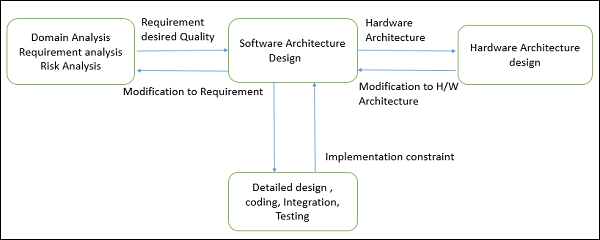Software Architecture
Architecture serves as a blueprint for a system. It provides an abstraction to manage the system complexity and establish a communication and coordination mechanism among components.
-
It defines a structured solution to meet all the technical and operational requirements, while optimizing the common quality attributes like performance and security.
-
Further, it involves a set of significant decisions about the organization related to software development and each of these decisions can have a considerable impact on quality, maintainability, performance, and the overall success of the final product. These decisions comprise of −
-
Selection of structural elements and their interfaces by which the system is composed.
-
Behavior as specified in collaborations among those elements.
-
Composition of these structural and behavioral elements into large subsystem.
-
Architectural decisions align with business objectives.
-
Architectural styles guide the organization.
-
Software Design
Software design provides a design plan that describes the elements of a system, how they fit, and work together to fulfill the requirement of the system. The objectives of having a design plan are as follows −
-
To negotiate system requirements, and to set expectations with customers, marketing, and management personnel.
-
Act as a blueprint during the development process.
-
Guide the implementation tasks, including detailed design, coding, integration, and testing.
It comes before the detailed design, coding, integration, and testing and after the domain analysis, requirements analysis, and risk analysis.

Goals of Architecture
The primary goal of the architecture is to identify requirements that affect the structure of the application. A well-laid architecture reduces the business risks associated with building a technical solution and builds a bridge between business and technical requirements.
Some of the other goals are as follows −
-
Expose the structure of the system, but hide its implementation details.
-
Realize all the use-cases and scenarios.
-
Try to address the requirements of various stakeholders.
-
Handle both functional and quality requirements.
-
Reduce the goal of ownership and improve the organization’s market position.
-
Improve quality and functionality offered by the system.
-
Improve external confidence in either the organization or system.
https://www.tutorialspoint.com/software_architecture_design/introduction.htm